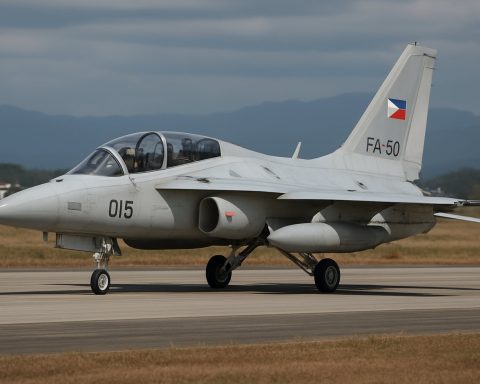- The Czech Republic is extending its use of the Saab JAS-39C Gripen jets while moving towards acquiring F-35 aircraft, reflecting strategic air force recalibration in Europe.
- Negotiations with Sweden resulted in a 25% cost reduction for the Gripen contract, valued at 16.65 billion CZK ($732 million), including maintenance and training.
- Czech plans include upgrading the Gripens with an additional 3.9 billion CZK investment to enhance battlefield capabilities amidst evolving security needs.
- The phased transition ensures uninterrupted airspace control until the F-35s arrive by 2031, highlighting a strategic balance between current capabilities and future advancements.
- This approach underscores Czech commitment to maintaining air superiority through astute defense spending and modernized aviation technology.
High above the serene landscapes of Zeltweg, Austria, a Saab JAS-39C Gripen roars through the skies with elegance and power—a mechanical bird of prey, looping gracefully to the awe of spectators. The gripping scene is emblematic of a more profound narrative unfolding across Europe, where Prague’s strategic air force recalibration unfolds in delicate negotiations and bold aspirations.
In the picturesque city of Belfast, the Czech Republic stirs the pot of international defense contracts. All eyes are focused on the country’s decision to extend its use of the agile Gripen C/D jets—a Swedish marvel of modern aviation—while setting sights on the illustrious F-35, the future crown jewel of their defense arsenal.
Negotiating with Sweden was no waltz in a ballroom. Initial offers clashed with expectations in Prague, evoking intense dialogue reminiscent of a high-stakes chess match. Yet, persistence bore fruit. The long discussions yielded an advantageous new offer, dramatically sliced by 25 percent of its initial price tag—an irresistible deal poised at 16.65 billion CZK ($732 million). This financial finesse allows for nimble adjustments—12 remaining Gripens, primed for operational excellence, awaiting their eventual succession by F-35s.
This transitional phase, though challenging, is fiercely strategic. Operating the sleek Gripens until F-35s touch Czech soil in 2031 ensures continuous airspace domination—a non-negotiable for any sovereign nation. The offer envelops extended aircraft maintenance and comprehensive pilot training—investments splendidly shrouded in stealth against escalating costs typical of the military aviation sector.
Yet, such astuteness in defense allocations does not end here. The Czech Republic has plans underfoot to modernize its Gripens in response to emerging battlefield conundrums. An additional 3.9 billion CZK is earmarked for sophisticated upgrades, aligning with a changing world where air power remains a vital piece of national security.
Thus, as wings of the Gripen cut through rarefied air, below lies an intricate dance of diplomacy, economics, and futuristic vision. With meticulous care, the Czech Republic is sculpting its aerial future, balancing present necessity with a horizon filled with F-35 promise. A tale etched in the sky speaks to a universal audience—the art of preparation, strategic insight, and the ceaseless drive for progress.
Why the Czech Republic’s Defense Strategy is a Masterclass in Modern Aviation
The Czech Republic’s strategic decisions in aviation defense—signified by their ongoing use and eventual replacement of the Saab JAS-39C/D Gripens with the advanced F-35s—highlight a broader European narrative of adaptation and innovation in military strategy. By critically evaluating multiple factors, including cost efficiencies, operational capabilities, and future technologies, this strategy serves as a blueprint for other nations facing similar defense modernization challenges.
Key Insights on the Czech Republic’s Aviation Strategy
Current Landscape and Strategic Decisions
1. Cost Efficiency and Negotiation Success:
– The Czech Republic’s defense ministry secured a 25% reduction in costs with the Swedish defense contractor, which translates to significant savings for the nation. This deal reaffirmed the Czech commitment to strategic financial management in defense.
2. Gripen Modernization Plans:
– An additional 3.9 billion CZK ($171 million) is allocated for upgrading Gripen C/D jets. These upgrades aim to ensure the fleet remains competitive amid rapidly evolving global air combat requirements.
3. Transition to the F-35 Platform:
– The plan to transition from Gripens to F-35s by 2031 is crucial for maintaining air superiority. The F-35, known for its stealth, cutting-edge avionics, and multi-role capabilities, is expected to bolster the Czech Air Force’s operational readiness substantially.
Analyzing the Future of Czech Aviation
– Technological Superiority: The F-35 is renowned for its advanced features, including stealth technology and superior electronics, making it a formidable choice for future aerial combat scenarios.
– Long-term Training Investments: Comprehensive pilot training is integral to effectively operate new aircraft systems. The Czech Republic’s focus on training ensures a seamless transition to new platforms.
– Operational Continuity: By keeping the Gripens operational until 2031, the Czech Republic safeguards its aerial defense capabilities throughout the transition period.
How-To Steps for Implementing a Similar Defense Strategy
1. Conduct Thorough Market Research: Understanding available aircraft technologies and developing cost analyses are critical before negotiations.
2. Engage in Strategic Negotiations: Utilize diplomatic skill to secure financially and strategically advantageous deals.
3. Plan for Continuous Upgrades: Allocate resources for consistent upgrades to ensure aircraft fleets meet contemporary combat demands.
4. Develop a Transition Roadmap: Outline specific timelines and benchmarks for transitioning to new technologies.
Real-World Use Cases and Industry Trends
– Defense Partnerships: Similar strategies can be observed in other nations like Finland and Switzerland, which also opted for the F-35, highlighting a trend of upgrading to stealth-capable multirole fighters.
– Advanced Training Programs: The integration of virtual reality and AI into pilot training programs is a growing trend to reduce costs and increase training effectiveness.
Pros & Cons Overview
Pros:
– Cost-Effective Transition: Significant savings enable reallocation of funds to other defense sectors.
– Technological Advancement: Transition to F-35 enhances capabilities significantly.
– Strategic Defense Alliances: Strengthens international relations through collaborative defense contracts.
Cons:
– Operational Costs: The F-35’s ongoing maintenance and operational costs can be high.
– Complex Integration: Transitioning systems and personnel to new platforms is challenging.
Actionable Recommendations
1. Monitor Technological Developments: Regularly assess advancements in military aviation to remain competitive.
2. Optimize Training Protocols: Utilize modern simulation technologies to prepare pilots for new systems efficiently.
3. Strengthen International Defense Ties: Engage with global defense partners to share best practices and technologies.
The Czech Republic’s prudent defense strategy reflects an impressive alignment of diplomacy, economic foresight, and technological adaptation, setting a compelling example for other nations in the pursuit of sustained aerial dominance and national security. For more insights into defense strategies, visit Defense.gov.







